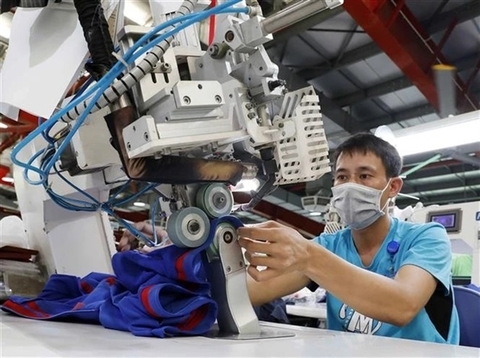
A worker at Maxport Thái Bình, a textile company in the northern province of Thái Bình. — VNA/VNS Photo Trần Việt
Enhancing the quality of the workforce, promoting regional linkages, and developing science, technology, innovation and digital transformation are keys to Việt Nam's focus on improving labour productivity in the coming decades, according to the recently approved National Programme on Labour Productivity Enhancement by 2030.
The Southeast Asian economy has set a target by 2030 for an average national labour productivity growth rate of over 6.5 per cent per year, with the labour productivity growth rates of key economic regions and five centrally governed cities expected to surpass the national average during the 2023-2030 period, striving to be among the top three countries in Southeast Asia in terms of labour productivity growth. The target is also to have an average annual increase of 15 per cent in the number of enterprises engaging in innovative activities by 2025, and 20 per cent by 2030.
According to Đậu Anh Tuấn, deputy secretary-general of the Việt Nam Chamber of Commerce and Industry (VCCI), a large number of businesses are currently experiencing low labour quality, which has been identified as a significant challenge, considering that only about 15 per cent of the workforce has a higher education degree.
Nguyễn Bích Lâm, former head of the General Statistics Office (GSO), said while Việt Nam's labour productivity had narrowed the gap with higher-developed ASEAN countries, it still lagged behind countries like Singapore, Malaysia and Thailand, not to mention others such as South Korea, Japan, China or Western nations such as the UK, France and the US.
Contributing factors included the inappropriate structure of the labour force across industries, with the leading role of domestic productivity not fully realised, limited application of technology and techniques in production and outdated machinery and technology.
To enhance Việt Nam's competitiveness, Lâm advised the Government to conduct regular reviews and evaluations of the National Labour Productivity Programme, in line with the global economic transformation. Industries and regions must proactively anticipate events, evaluating the impact of opportunities and challenges arising from global economic changes on Việt Nam. From this, solutions could be proposed to stabilise the macroeconomy, improve labour productivity, and promote rapid and sustainable growth.
He recommended continuous reform and improvement of institutional mechanisms to expedite the efficient use of all resources. Simultaneously, a cohesive legal environment needed to be established to ensure healthy competition across all markets. Creating mechanisms, preferential policies, and specific support for businesses to implement innovative solutions, adopt new technologies, and prioritise digital and high-tech industries was crucial.
In addition, refining growth strategies focusing on exports to maximise benefits from free trade agreements or developing a national strategy for technology-driven businesses, prioritising digital and high-tech sectors, design and innovation, was essential. Each enterprise should formulate and implement a strategy to enhance labour productivity based on knowledge and technology. Investing in innovation, applying advanced and modern technology to production and business management, and continuously innovating production processes tailored to each industry and economic region would be crucial steps.
Meanwhile, companies should evaluate each stage of the production process to restructure their workforce, develop automated production processes, or invest in industrial robots and artificial intelligence to enhance labour productivity, reduce product costs and improve competitiveness. — VNS